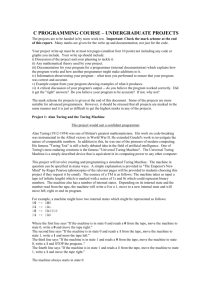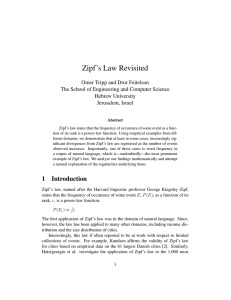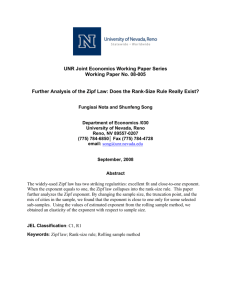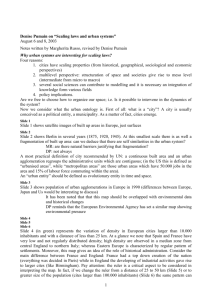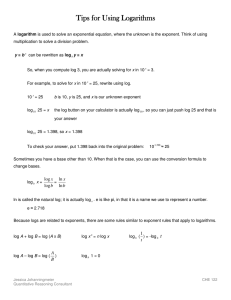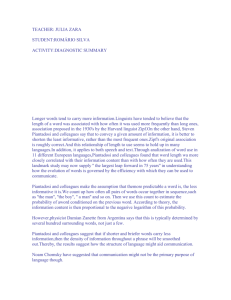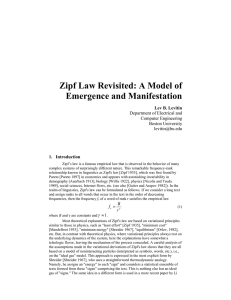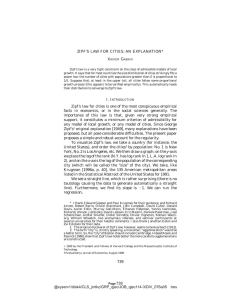Document 13574386
advertisement
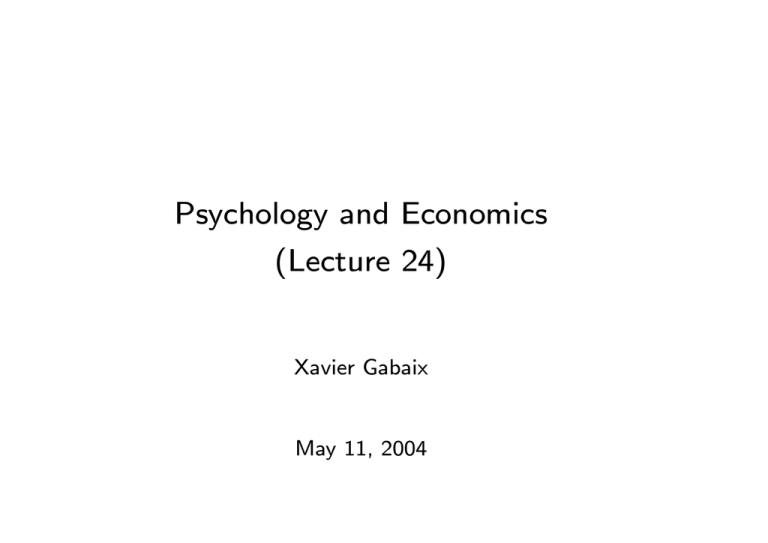
Psychology and Economics (Lecture 24) Xavier Gabaix May 11, 2004 1 Animal metabolism and other “universal” laws • How much energy E does one need to make an animal of size M function? • The naive guess would be CRS: E ∼ M If the size of the animal doubles, one needs twice the amount of energy. • But Nature does better than that. • If the size of the animal double, one needs less than twice the amount of energy. E ∼ M 3/4 3 ln E = a + ln M 4 • Explanation: West, Brown, Enquist (Science ’97, Nature ’99). • Lots of “universal” laws similar in biology, physics. Understanding them is a hot area of research. • In physics, “universality” has a precise, technical meaning: after rescal­ ing, different metals etc. behave exactly the same. • Perhaps there should be in economics: — Zipf’s law P (Size > x) ∼ x−1: Cities, Firms (Axtell, Science ’01) — Power law in the stock market: 3 for returns and number of trades, 3/2 for volumes. Theory in Gabaix et al. (Nature ’03). 2 Zipf’s law • That’s the statement that ζ = 1. • Original Zipf’s law: Frequency of words in a text: Estoup (1916), Zipf (1949) • Original power law in economics: For incomes, Pareto (1897) • Zipf’s law holds for cities • Take U.S. Order cities by size. Largest: NYC = #1, LA =#2,... • Regression with the 135 largest American metropolitan areas 1991. ln Rank = 10.53 − 1.005 ln Size (.010) (1) • R2 = .986. (No tautology) “One of the strongest [non­trivial] facts in social sciences”. • This means ln P (Size> S) = a − ζ ln S with ζ ≃ 1, or P (Size > S) ∼ S −ζ (2) • If largest city has 10 million inhabitants, the 10th city has 1 million, the 100th city 100,000... + interpretation with ratios • One first explanation: Monkeys at a typewriter (Mandelbrot, 1961). Exercise: Work it out. 3 Power laws in Economics k F (x) = P (S > x) ≃ ζ x kζ ′ f (x) = −F (x) = ζ+1 x • Empirically, we see: ln P (S > x) ≃ −ζ ln x + c ln f (x) ≃ − (ζ + 1) ln x + c ′ 3.1 Simplest way to estimate ζ • Rank units by size: S(1) ≥ S(2) ≥ . . . • Plot lnSize vs lnRank • See above which size one has a straight line • In that domain, run: ln Rank = −ζ ln Size + C • True standard error: ζ2/n. 4 Axtell (2001) • Studies the 5 million firms in the US, in 1997. ln f (S) = a − (ζ + 1) ln S R2 = 0.993 ζ = 1.059 ≃ 1 That’s Zipf’s law: ζ = 1. 5 Other domains for Zipf’s law • Firms, size of bankruptcy, number of workers in strikes, exports • Assets under management of mutual funds • Popularity (number of clicks) of internet sites: Huberman (1999), Barabasi and Albert (1999) • ζ =“power law exponent”=“Pareto exponent” • Low ζ means high inequality. • “Universal” laws: Same laws in different countries, time period, eco­ nomic structures, trading mechanisms. • →Need simple explanations that do not depend on the details of the system. Ideally, we want no tunable parameters. • Other quantitative “laws” in economics? (besides Black­Sholes): Quan­ tity theory of money P Y ∼ M . 6 Lots of power laws in physics • Similar power laws are found in: earthquakes, solar eruptions, extinc­ tion of species, pieces of a vase. • No general theory explains them and they do not have a ”mathematical ” exponent like 1. • Reference: Didier Sornette, “Critical Phenomena in Natural Sciences” (Springer , 2003) • Work often done by / with physicists (“econophysics”, ∼ 150 physi­ cists working on this). More empirical that “Sante Fe” research, “com­ plexity theory”. 7 An explanation. Zipf’s law with exponent 1 • Start from an arbitrary initial distribution. • Cities follow similar processes: e.g. grow at 2%/year, ±.5%. (”Gibrat’s law”). • Consequence: the distribution converges to a steady state distribution which is Zipf, with exponent 1. • The explanation is robust to new cities, several regions with different means and variances. • Gibrat’s law appears to be true empirically. 8 From Gibrat’s law to Zipf’s law (Gabaix ’99) • Sti =(Size of city i at time t) / (Total expected population at time t). N Sti = 1 (3) Sti+1 = γti+1Sti (4) E i=1 • Evolution where γti+1 =normalized growth rate of city i. i.i.d. and independent of i, with probability density f (γ). • (3) and (4) imply: E[γti+1] = 1, or ∞ 0 γf (γ)dγ = 1 (5) • Distribution: Gt(S) = P (St > S) has equation of motion: Gt+1(S) = P (St+1 > S) = P (γt+1St > S) = E[1St>S/γt+1 ] = E[E[1St>S/γt+1 |γt+1]] = E[Gt(S/γt+1)] = ∞ 0 Gt(S/γ)f (γ)dγ (6) • Suppose that there is a steady state Gt = G. It verifies G(S) = ∞ 0 G(S/γ)f (γ)dγ (7) • Try the solution G(S) = a/S (=Zipf’s law), using (5): ∞ 0 G(S/γ)f (γ)dγ = ∞ 0 a/(S/γ)f (γ)dγ = a/S · ∞ = G(S) 0 γf (g)dγ = a/S • So G(S) = a/S satisfies the equation (7) of steady­state process: It works. • In fact (Theorem), there is a steady state distribution, and it must be a/S.
